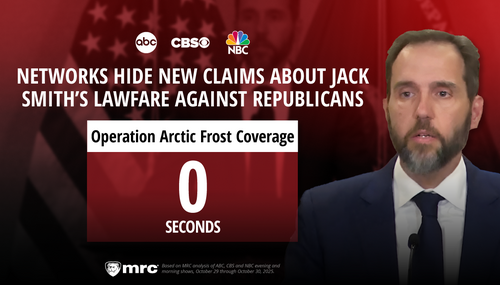While the liberal media all went wild over Time magazine’s latest photoshopped cover depicting an aloof President Trump towering over a crying immigrant child, on Friday, only CBS This Morning took the time to correct the record and explain how “misleading” that doctored image was. Unlike NBC or ABC, the broadcast network actually sought out the Border Patrol agent who first encountered the child and her mother, explaining that the two were not separated.
“The picture of a Honduran child crying as she and her mother are detained in Texas has grabbed people’s attention worldwide. Time magazine put her on its cover but the photo might be a little misleading,” admitted co-host Norah O’Donnell. Reporting from Texas, correspondent David Begnaud further cautioned: “You may have seen the photo, you may have shared it on social media. A lot of people have. And with it, there’s been a lot of misinformation that’s been spread.”
Introducing his exclusive interview with Border Patrol Agent Carlos Ruiz, Begnaud explained to viewers: “But let me tell you this, the Border Patrol has told us probably five times over the last 24 hours that the family was never separated while they were in the custody of Border Patrol, not at the scene or the first 72 hours that they were in the custody of the Border Patrol.”
Ruiz recounted his interaction with the immigrant family after they crossed the U.S. border illegally:
We asked her to set the kid down in front of her, not away from her. She was right in front of her. And so we can properly search the mother. So, the kind immediately started crying as she set her down. I personally went up to the mother and asked her, “Are you doing okay and is the kid okay?” And she said, “Yes, she’s tired and thirsty, it’s 11:00 at night.”
Getty photographer John Moore, who took the picture, was also featured the in segment and Begnaud noted: “Moore’s image is now on the cover of Time magazine, next to a picture of the president.”
Another soundbite followed of Ruiz criticizing the cover: “They’re using it to symbolize a policy, and that was not the case in this picture. It took less than two minutes and as soon as the search was finished, she immediately picked the girl up and the girl immediately stopped crying.”
Begnaud hastened to add: “Moore says Ruiz and other agents acted professionally that night, but he is happy with the cover and the response to the image.” A clip ran of a satisfied Moore declaring: “Oftentimes immigration is talked about in terms of statistics. And when you put a human face and you humanize an issue, you make people feel. And when you make people feel, they have compassion. And if I’ve done just a little bit of that, then that’s okay.”
Apparently it’s okay for a news publication to use a deceptive image as long as “you make people feel.”
Ruiz defended himself and his fellow Border Patrol agents: “We are also fathers, we are also sons, we also have families, and we do care and we do our jobs and we treat these people as humanely and as best as we possibly can.”
Following the report, co-host Gayle King praised Begnaud for showing “the other side of that picture”:
But it’s also good, David, to show the other side of that picture. When we were there, we were at the House of Pancakes, the waiters came over and said, “You guys should really talk about the Border Patrol agents. They’re fathers, they’re husbands, they’re doing a job, and I feel that the media’s vilifying them.” So I think it’s very interesting that you found that particular man to hear his side of the story.
The reporter replied: “It’s only fair.” King agreed: “Right, it’s only fair...I wanted to know the back story, thank you very much.” O’Donnell added: “Great reporting.”
Here is a full transcript of the June 22 report:
7:31 AM ET
NORAH O’DONNELL: For the first time, we’re hearing from a Border Patrol agent involved in a dramatic scene that’s come to symbolize U.S. immigration policy. The picture of a Honduran child crying as she and her mother are detained in Texas has grabbed people’s attention worldwide. Time magazine put her on its cover but the photo might be a little misleading. In an interview you’ll see only on CBS This Morning, the border agent shows us what happened in the moment the [photo] was taken. David Begnaud is with us again from McAllen [Texas]. David, good morning.
DAVID BEGNAUD: Norah, good morning. You may have seen the photo, you may have shared it on social media. A lot of people have. And with it, there’s been a lot of misinformation that’s been spread. We spent all week trying to secure an interview with this agent because we wanted to get his account. So this morning you’re going to hear from the agent and the photographer. But let me tell you this, the Border Patrol has told us probably five times over the last 24 hours that the family was never separated while they were in the custody of Border Patrol, not at the scene or the first 72 hours that they were in the custody of the Border Patrol. Here now, is that agent.
[ON-SCREEN HEADLINE: A Moment In Time; Border Patrol Agent & Photographer Share Story Behind Iconic Photo]
CARLOS RUIZ [BORDER PATROL AGENT]: We were patrolling the border, it was after 10:00 at night.
BEGNAUD: That is Border Patrol Agent Carlos Ruiz, who says he was the first to encounter Sandra Sanchez and her young daughter after they allegedly crossed the Rio Grande River into Texas illegally.
RUIZ: We asked her to set the kid down in front of her, not away from her. She was right in front of her. And so we can properly search the mother. So, the kind immediately started crying as she set her down. I personally went up to the mother and asked her, “Are you doing okay and is the kid okay?” And she said, “Yes, she’s tired and thirsty, it’s 11:00 at night.”
JOHN MOORE [GETTY PHOTOGRAPHER]: When I took this picture, I knew it would be important. I had no way of knowing that it would touch people quite on the level that it has.
BEGNAUD: That’s Getty photographer John Moore, who joined Ruiz for a nearly nine-hour ride-a-long on the border. He was just feet from Sanchez and the little girl.
MOORE: I asked her how long she had been traveling and she gave me this very weary look and she said she’d been on the road with her daughter for a month. Imagine doing that with children. It’s almost impossible to imagine, actually.
BEGNAUD: Moore’s image is now on the cover of Time magazine, next to a picture of the president.
RUIZ: They’re using it to symbolize a policy, and that was not the case in this picture. It took less than two minutes and as soon as the search was finished, she immediately picked the girl up and the girl immediately stopped crying.
BEGNAUD: Moore says Ruiz and other agents acted professionally that night, but he is happy with the cover and the response to the image.
MOORE: Oftentimes immigration is talked about in terms of statistics. And when you put a human face and you humanize an issue, you make people feel. And when you make people feel, they have compassion. And if I’ve done just a little bit of that, then that’s okay.
RUIZ: We are also fathers, we are also sons, we also have families, and we do care and we do our jobs and we treat these people as humanely and as best as we possibly can.
BEGNAUD: The mother and daughter were arrested on June 10th. Now, they only stayed in the custody of Border Patrol for 72 hours. They have to then be turned over to Health and Human Services. 15 minutes ago, I called Border Patrol in Washington and I said, “Where did they go when you let them go and turned them over to HHS?” Gayle, we were just told, “We don’t know where they are.” And this morning, we aren’t able to find out. We cannot tell you where they are as of this morning.
And it’s worth pointing out, Gayle, when most people get arrested in this country, we can find out where they’re being detained, when they were booked in, and when they’re seeing a judge. In these immigration cases, we cannot get those answers.
GAYLE KING: Exactly, that is such a good point. That’s why this story is so difficult to see. But it’s also good, David, to show the other side of that picture. When we were there, we were at the House of Pancakes, the waiters came over and said, “You guys should really talk about the Border Patrol agents. They’re fathers, they’re husbands, they’re doing a job, and I feel that the media’s vilifying them.” So I think it’s very interesting that you found that particular man to hear his side of the story.
BEGNAUD: It’s only fair.
O’DONNELL: Yeah, that’s right.
KING: Right, it’s only fair.
JOHN DICKERSON: Bravo, David.
KING: I wanted to know the back story, thank you very much.
O’DONNELL: Great reporting.




